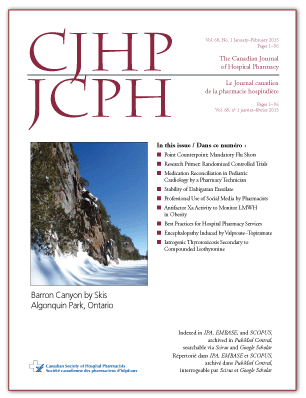Measuring Anti–Factor Xa Activity to Monitor Low-Molecular-Weight Heparin in Obesity: A Critical Review
DOI:
https://doi.org/10.4212/cjhp.v68i1.1423Keywords:
low-molecular-weight heparin, anti–factor Xa, anti-Xa, therapeutic drug monitoring, héparine de bas poids moléculaire, anti-facteur Xa, suivi thérapeutique pharmacologiqueAbstract
ABSTRACT
Background: The choice of whether to monitor anti–factor Xa (anti-Xa) activity in patients who are obese and who are receiving low-molecularweight heparin (LMWH) therapy is controversial. To the authors’ knowledge, no systematic review of monitoring of anti-Xa activity in such patients has been published to date.
Objective: To systematically ascertain the utility of monitoring anti-Xa concentrations for LMWH therapy in obese patients. Data Sources: MEDLINE (1946 to September 2014), the Cochrane Database of Systematic Reviews, Embase (1974 to September 2014), PubMed (1947 to September 2014), International Pharmaceutical Abstracts (1970 to September 2014), and Scopus were searched using the terms obesity, morbid obesity, thrombosis, venous thrombosis, embolism, venous thromboembolism, pulmonary embolism, low-molecular weight heparin, enoxaparin, dalteparin, tinzaparin, anti-factor Xa, anti-factor Xa monitoring, anti-factor Xa activity, and anti-factor Xa assay. The reference lists of retrieved articles were also reviewed.
Study Selection and Data Extraction: English-language studies describing obese patients treated with LMWH or reporting anti-Xa activity were reviewed using a 9-step decision-making algorithm to determine whether monitoring of LMWH therapy by means of anti-Xa activity in obesity is warranted. Studies published in abstract form were excluded.
Data Synthesis: The analysis showed that anti-Xa concentrations are not strongly associated with thrombosis or hemorrhage. In clinical studies of LMWH for thromboprophylaxis in bariatric surgery, orthopedic surgery, general surgery, and medical patients, and for treatment of venous thrombo embolism and acute coronary syndrome, anti-Xa activity can be predicted from dose of LMWH and total body weight; no difference in clinical outcome was found between obese and non-obese participants.
Conclusions: Routinely determining anti-Xa concentrations in obese patients to monitor the clinical effectiveness of LMWH is not warranted on the basis of the current evidence. Circumstances where measurement of anti-Xa concentration may help in clinical decision-making in either obese or non-obese patients would be cases where elimination of LMWH is impaired or there is an unexpected clinical response, as well as to confirm compliance with therapy or to identify deviation from predicted pharmacokinetics.
RÉSUMÉ
Contexte : Choisir d’effectuer ou non une surveillance de l’activité de l’anti-facteur Xa (anti-Xa) chez le patient obèse qui reçoit un traitement par héparine de bas poids moléculaire (HBPM) est controversé. À la connaissance des auteurs, aucune analyse systématique de la surveillance de l’activité anti-Xa chez ce type de patient n’a été publiée à ce jour.
Objectif : Établir systématiquement l’utilité de la surveillance des concentrations d’anti-Xa pour le traitement par HBPM chez le patient obèse.
Sources des données : Les bases de données MEDLINE (de 1946 à septembre 2014), Cochrane Database of Systematic Reviews, Embase (de 1974 à septembre 2014), PubMed (de 1947 à septembre 2014), International Pharmaceutical Abstracts (de 1970 à septembre 2014) et Scopus ont été interrogées à l’aide des termes obésité, obésité morbide, thrombose, thrombose veineuse, embolie, événement thromboembolique veineux, embolie pulmonaire, héparine de bas poids moléculaire, énoxaparine, daltéparine, tinzaparine, anti-facteur Xa, surveillance de l’anti-facteur Xa, activité anti-facteur Xa et analyse de l’activité anti-facteur Xa. Un examen des bibliographies des articles extraits a aussi été réalisé.
Sélection des études et extraction des données : Les études en anglais présentant des patients obèses traités par HBPM ou signalant l’activité anti-Xa ont été examinées à l’aide d’un algorithme de prise de décision à neuf étapes dans le but de déterminer s’il est justifié de réaliser une surveillance des HBPM en mesurant l’activité anti-Xa dans les cas d’obésité. Les études publiées sous forme de résumé étaient exclues.
Synthèse des données : Les concentrations d’anti-Xa ne sont pas fortement associées aux thromboses ou aux hémorragies. Dans les études cliniques sur la thromboprophylaxie en chirurgie bariatrique, en chirurgie orthopédique, en chirurgie générale et chez le patient médical, et sur le traitement de la thromboembolie veineuse et du syndrome coronarien aigu, l’activité anti-Xa peut être prédite à l’aide de la dose de HBPM et du poids total du patient. Aucune différence dans les résultats cliniques entre les sujets obèses et non obèses n’a été trouvée.
Conclusions : À la lumière des données probantes actuelles, il n’est pas justifié d’effectuer une analyse systématique des concentrations d’anti-Xa chez le patient obèse afin de surveiller l’efficacité clinique des HBPM. Il reste tout de même des situations pour lesquelles l’analyse des concentrations d’anti-Xa chez le patient obèse ou non obèse pourrait aider à prendre une décision clinique : présence d’une élimination déficiente des HBPM, survenue d’une réaction clinique inattendue, confirmation de l’observance du traitement ou explication d’un écart de la pharmacocinétique prévue.
Downloads
Downloads
Published
Issue
Section
License
Copyright © Canadian Society of Healthcare-Systems Pharmacy.
After publication of a manuscript in the CJHP, the authors of the manuscript must obtain written permission from the CSHP (publications@cshp.ca) before reproducing any text, figures, tables, or illustrations from the work in future works of their own. If a submitted manuscript is declined for publication in the CJHP, all said rights shall revert to the authors. Please note that any forms (e.g., preprinted orders and patient intake forms) used by a specific hospital or other health care facility and included as illustrative material with a manuscript are exempt from this copyright transfer. The CJHP will require a letter from the hospital or health care facility granting permission to publish the document(s).










